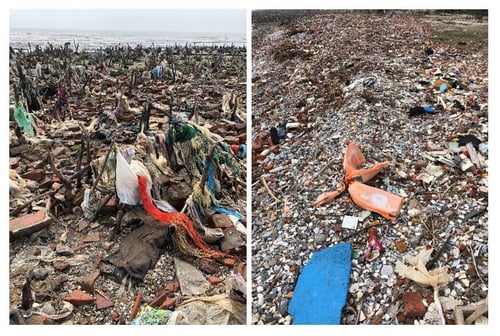Gepubliceerd op 26 maart 2022
In order to tackle plastic pollution, we first need to clarify how and where plastics really enter the ocean. Current field samplings and models only provide a small part of the answer. Remote sensing through satellites, drones and fixed cameras can enhance this understanding and provide ways to follow up implemented regulations. Discover how we combine our expertise in ocean optics, spectral image processing and AI to detect and characterize individual pieces of macro litter and accumulation areas, including a glimpse on the first results.
Detecting marine plastic litter! Where it all started
The use of remote sensing technologies to detect and characterize marine plastic litter is still fairly new. Although the technology is already used in industrial sorting, the application in an outdoor marine environment is much more complex. Several years ago VITO Remote Sensing started with the first experiments in a lab environment to first better characterize the spectral reflectance of marine plastics. It gave them insight on the effects of water, weathering and structure of the plastics. This was an essential first step to develop algorithms for plastic detection and select the most appropriate sensors to be used in the outdoor environment.
They’ve been using this knowledge to process images from both drones and fixed cameras in multiple marine plastic detection projects e.g. AIDMAP (ESA - The Discovery Campaign on Remote Sensing of Plastic Marine Litter ) and PLUXIN. In these research projects VITO focuses on the detection of plastic accumulation areas and individual pieces of plastic litter in rivers. Both can provide important information to understand the pathway of marine litter from source to sink and to support clean up actions.

Plastics trapped in a dead mangrove forest and a beach in Vietnam.
Picture taken by Assoc. Prof. Dr. PHAM Minh Hai, Vietnam Institute of Geodesy and Cartography.
Detecting litter accumulation with drones
In VITO Remote Sensing's latest projects they’ve been focusing on the development of new remote sensing based solutions to:
- detect litter accumulations,
- discriminate it from its surroundings (being water, sand…)
- estimate the percentage of plastics in the accumulation area
A few months ago, in November 2021, they performed an experiment on the Sibelco lake in Belgium to detect litter accumulations by using a drone equipped with a multispectral camera and machine learning. TYhey placed litter accumulations which were artificially created using weathered plastics from the Port of Antwerp and the Scheldt river, and washed ashore plastics in Vietnam on both land and water surfaces. The litter included plastics, but also pieces of wood and reed.
Read the rest of the article
on the VITO Remote Sensing blog